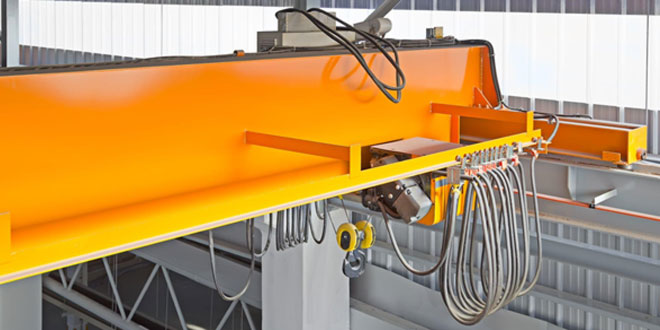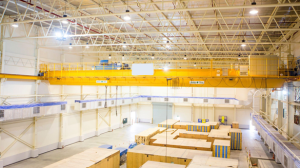
Cranes are an integral part of many industries across construction, engineering, warehouse and factory work. Predominantly used for lifting and handling heavy objects and materials, these powerful objects take the strain off workers whilst offering a productive and efficient solution. There are a number of different crane models and types out there, each one offering different benefits and purposes. Though with this powerful machinery comes plenty of hazards and dangers to consider, so let’s take a look at the safety precautions involved and potential hazards which could occur when working with overhead cranes.
An overhead crane is a type of heavy-duty machinery that is capable of transporting heavy loads and equipment from one location to another, doing so in a safe and accurate manner. These crane types come in a variety of sizes, shapes and configurations, fitted with necessary components and accessories. Mainly used for loading, unloading, moving materials and lifting, overhead cranes are the ideal solution for efficiency and safety.
If you’re dealing with cranes in a working environment, it’s essential to be aware of the hazards and issues that may be caused. These hazards may lead to harm, injury or danger and must be avoided in any industry.
One of the main safety points when it comes to using overhead cranes is acquiring the correct staff training. This machinery should only be used and operated by qualified employees who are trained and qualified in the correct areas. These training schemes will not only ensure the machinery is being used correctly and safely but will also highlight all the major safety precautions to look out for.
The weight limit for overhead cranes and handling systems is there to avoid hazards, damage and danger from occurring so should be considered before each use. It’s crucial to stick to these limits and not overload the crane as this could lead to a number of issues with staff, produce, flooring and the equipment itself.
Regular inspections of the workplace and stations are critical for staff, visitors and the running of a business. With construction and engineering industries in specific, these inspections are even more necessary to ensure everything is working correctly, stations are safe to work in and the environment is fit for purpose. These inspections will then lead to repairs and maintenance to avoid any further damage or hazard.
Operating trial runs of all machinery is a key technique used throughout factories and warehouses. These runs are used to make sure each station is running as it should, highlighting any issues without impacting products or goods. Trial runs are also helpful after repairs or maintenance has been made to make sure these changes have been effective.
Workers must ensure that they are not standing in the operation area or under the crane where loads are being transported to avoid any harm being caused. The planning and route for the lifting process should be designated in advance so that workers can avoid certain areas and are aware of where and where not to stand.
Creating adequate signing throughout the workplace will ensure staff and visitors are aware of any safety requirements for the specific area they are in. These signs could include protection wear e.g. goggles, stop-and-go lights, standing areas, hazards, chemical warnings or crane specifications.
Supplying all staff members and visitors with protective equipment is vital when working in factories, plants and warehouses. Used to avoid injury and exposure to harmful surroundings, these accessories and clothing should be given to everyone entering a workstation.
Investing in alarms or sensors can help with a number of things when it comes to overhead crane operation. These signs will alert everyone around that movement is about to happen and clear the space. This can also benefit the operator as they will be alerted of any disruptions, barriers or issues.

Here are a few more safety solution tips when using overhead cranes.
When it comes to hazards and overhead cranes, there are common hazards of a workplace and three main crane hazards which could occur, including electrical, overloading and material displacement. These hazards can harm the employees, workplace facilities and equipment and are the main issues to avoid when working with these powerful crane types.
Electrical hazards: Operators and workers must receive adequate training to avoid danger zones where electrocution could occur due to the high volts being used. However, electric hazards can be caused by the crane itself. Nearly 50 per cent of overhead crane accidents are the result of machinery coming into contact with a power source.
Overloading: Each crane will have its own operational capacity which should never be surpassed. When a crane is overloaded, it faces structural stress which could lead to irrevocable damage and also a hazard in regards to heavy loads being dropped or dragged. This overloading process could very easily break the crane and shut the system down completely.
Material displacement: Falling materials are a huge concern in any workplace operating an overhead crane. If materials are not properly secured or placed, the load can slip and land on workers or cause damage to the surrounding property. This is why it is so important to both check loading before transporting but also ensure the facility is completely clear.
Cranes are an essential part of a factory plan and workstation, making business more efficient and heavy lifting way more manageable. But in order for these cranes to be effective, safety must follow. By taking reasonable precautions and following accurate safety advice, harm can be avoided and more work can be carried out. There are a number of overhead cranes on the market and each requires research and consideration. Knowing which crane fits your business best is key.
Simon Cullingworth, Managing Director, Metreel, https://www.metreel.co.uk/